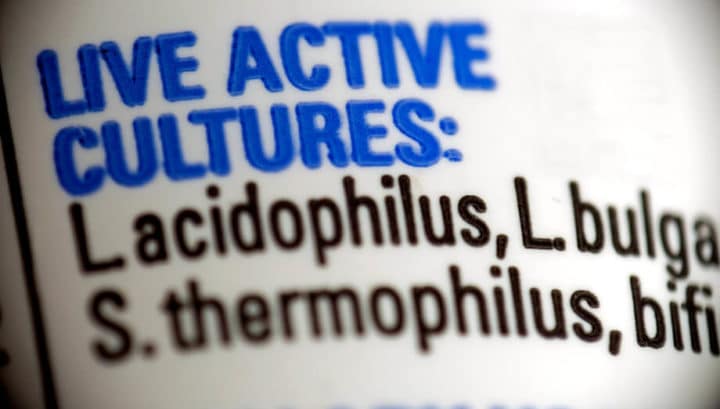We have all heard the commercials touting the positive effects of the probiotics found in products like yogurt. Probiotics, known as “good bacteria,” are live bacteria that are linked to a number of health benefits, including better digestion. Recent studies, however, suggest that probiotics could be useful for so much more than this. An important piece of research out of University College Cork, Ireland, shows that some probiotics may have a calming effect on the brain. This suggests that what is going on in your gut could actually affect the way you think.
In these experiments, mice were fed a diet high in a strain of lactobacillus, and researchers found that the presence of the bacteria altered the moods of the mice. The mice experienced reduced reactions to stress and anxiety, and much lower levels of stress hormones than the mice that received the placebo!
John Cryan, one of the authors of the study, said that this experiment demonstrated there was a direct neuron route from the gut to the brain, opening the door to the possibility of nutritional therapies for anxiety and stress.
The bacteria affected the GABA (a neurotransmitter) receptors in the brain, GABA being our main calming neurotransmitter. The results, says Cryan, mimicked the effect of Valium, a drug that has long been used to treat anxiety.
Cryan cautions that the findings don’t mean we should all go out and eat a gallon of yogurt. The bacteria used in the experiments are not commercially or clinically available, and different strains may create different effects. Human studies have not yet been conducted. However, he speculates other similar bacteria may behave the same way.
Lactobacillus, a strain of which was used in the experiments, is present in many fermented foods in various quantities. Some contain dead cultures because the food was processed with heat. Some, however, contain live cultures. The bacteria in sourdough bread, for example, are killed during the baking process, and the bacteria are removed from fermented wines and beers during the filtering process. However, live lactobacillus may be found in several products.
Food Sources Of Probiotic Bacteria
- Yogurt
Be sure to look for yogurts with live, active cultures. Some yogurts are heat-treated to both reduce yogurt’s natural tartness and to increase its shelf life. Some manufacturers will add probiotics after heat-treating the yogurt so they can be marketed as having probiotics. As part of a balanced diet, try to avoid yogurts with added sugars. - Buttermilk
Buttermilk was traditionally what was left over after butter was churned out of cream. This is called traditional buttermilk. Most buttermilk available on the market uses live cultures to ferment the sugar out of milk, which is known as cultured buttermilk. The bacterial action causes tart flavor. It only contains live cultures when drunk straight, but when used in cooking the probiotics are killed. - Cultured cottage cheese
Cultured cottage cheese differs from regular cottage cheese because it provides live cultures. Cultured cottage cheese tastes more tart than normal grocery store cottage cheese, and it can be a little difficult to find, but some grocery stores and many natural-food stores carry it. - Sauerkraut
Because cabbage is turned into sauerkraut through fermentation, it can be a good source of probiotics. If buying it at the store, look in the refrigerated section and be sure the label says that it contains live cultures. Canned sauerkraut has likely been heat treated in the canning process, which destroys live cultures. - Kefir
Kefir isn’t something included most people’s diets, but if you like yogurt you may like kefir as well. Kefir is often described as drinkable yogurt. The milk used in kefir is fermented with different kinds of probiotics than yogurt, however, and can be drunk plain or blended with fruits. - Kombucha
Kombucha is a drink made from the fermenting of yeast and bacteria in sweet tea. It creates a slightly carbonated, slightly sour drink that can be rich in probiotics. If purchasing in the grocery look for it in the refrigerated section and check to see if it contains live cultures. - Kimchi
This popular Korean condiment or side dish is a spicy, pickled combination of a number of vegetables. The main ingredient is cabbage, but it can include red pepper, radish, ginger, onion, and other ingredients. Freshly made kimchi in Asian markets will likely be high in probiotics, but when purchasing in the grocery store look for it in the refrigerated section and be sure that it contains live cultures. - Miso
Miso is a paste used in Japanese dishes as a seasoning. It’s made from fermenting cooked soybeans with either rice or barley, salt, and koji, which is a starter culture. The resulting paste can be used as a salt substitute, on in soups, sauces, dressings, dips. It also works great as a marinade. Be sure to get unpasteurized miso paste, located in the refrigerated section of grocery stores. To retain the probiotics, don’t cook with miso, simply add it to a dish right before removing it from heat.
Researchers speculate that other probiotics will probably have a similar effect to those used in these experiments, but conclusive studies have not yet been conducted to prove this. However, creating a high level of good bacteria in the gut is likely to make you feel better on many levels. Give it a try!
References & Further Reading
NPR, “Probiotic Bacteria Chill Out Anxious Mice”, http://www.npr.org/2011/09/02/140146780/probiotic-bacteria-chill-out-anxious-mice.




I guess I will believe that probiotics help in reducing stress levels. Perhaps it is this factor that backs up the claim that probiotics help strengthen the immune system.